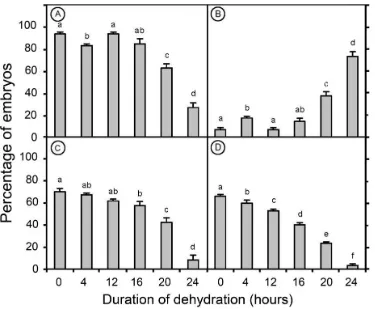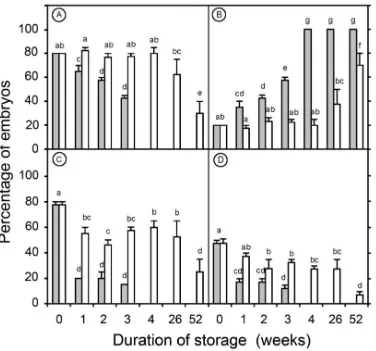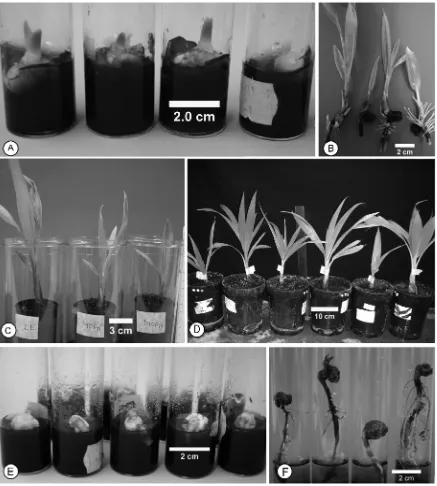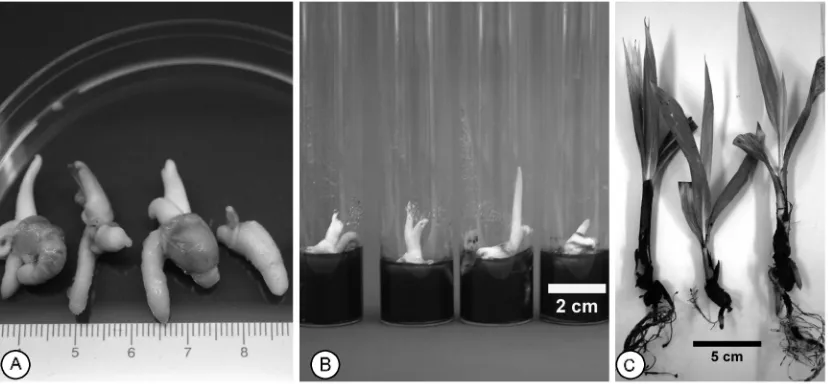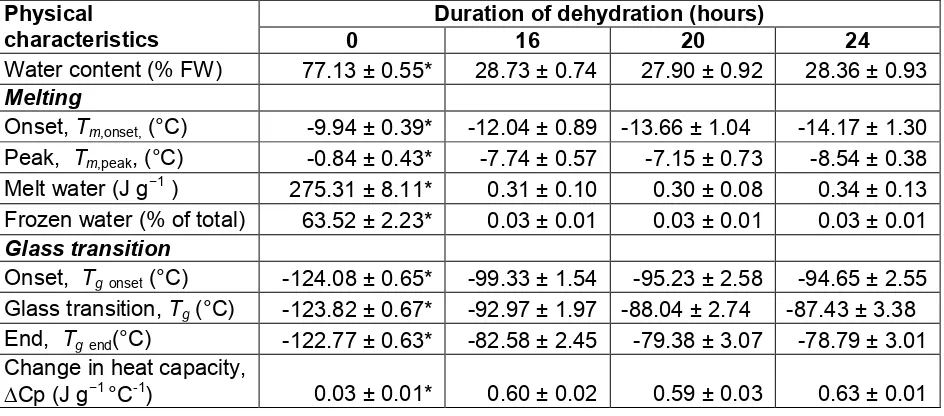CryoLetters33(6), 465-475 (2012)
© CryoLetters, [email protected]
CONSERVATION OF COCONUT (
Cocos nucifera
L.)
GERMPLASM AT SUB-ZERO TEMPERATURE
Sisunandar1,2*, Peter A Sopade3, Yohannes M S Samosir1,4, Alain Rival5 and Steve W Adkins1
1
The University of Queensland, Integrated Seed Research Unit, School of Agriculture and Food Sciences, St Lucia, Queensland, Australia 4072
2
The Muhammadiyah University of Purwokerto, Biology Education Department, Kampus Dukuhwaluh, Purwokerto, Indonesia, 53182.
3
The University of Queensland, Centre for Nutrition and Food Sciences, Queensland Alliance for Agriculture and Food Innovation, Queensland, Australia 4072
4
Bakrie Agriculture Research Institute (BARI), Bakrie Sumatera Plantations, Jl. Ir.Juanda 1, Kisaran 21202, North Sumatera, Indonesia
5
Cirad, UMR DIADE, Palm Developmental Biology Group, F-34398 Montpellier, France *Corresponding author email: [email protected]
Ph. +62281630463, Fax. +62281637239.
Abstract
Protocols are proposed for the low (-20°C) and ultra-low (-80°C) temperature storage of coconut (Cocos nucifera L.) embryos. A tissue dehydration step prior to storage, and a rapid warming step upon recovery optimized the protocol. The thermal properties of water located within the embryos were monitored using differential scanning calorimetry (DSC). In the most efficient version of the protocol, embryos were dehydrated under a sterile air flow in a dehydration solution containing glucose (3.33 M) and glycerol (15%) for16 hours. This protocol decreased the embryo water content from 77 to 29% FW and at the same time reduced the amount of freezable water down to 0.03%. The dehydrated embryos could be stored for up to 3 weeks at -20°C (12 % producing normal plants upon recovery) or 26 weeks at -80°C (28% producing normal plants upon recovery). These results indicate that it is possible to store coconut germplasm on a medium term basis using an ultra-deep freezer unit. However for more efficient, long term storage, cryopreservation remains the preferred option.
Keywords:dehydration, cryopreservation, differential scanning calorimetry, embryo culture, medium-term conservation, recalcitrant seeds.
INTRODUCTION
(e.g.typhoons), devastating diseases (e.g. lethal yellowing, cadang-cadang [10]) and pest (e.g. OryctesandBrontispa[13]). Alternativeex situconservation techniques such as seed banking has no application to coconut due to the unusually large seed size (600 to 3,000 g each; [14]) and their recalcitrant nature (12) which hampers long term storage. Therefore, an alternative method for the preservation of coconut germplasm material is needed.
A new method to preserve coconut germplasm through cryopreservation has been recently developed. This method shows that a large number of plants can be recovered (19, 21) and that no genetic or epigenetic changes were induced using this improved technology (20). Such a cryopreservation approach can be successfully implemented in well-equipped laboratories with a constant supply of liquid nitrogen. However, this would not be possible in the more remote facilities in which much of the present day coconut research and conservation activities take place.
An alternative approach for conserving coconut germplasm would be through the used of a deep (-20°C) or ultra-deep (-80°C) freezer unit. Even if this technique has been employed for many orthodox plant species (11, 22), only a few recalcitrant species have been successfully stored under such conditions.
The present paper reports on an innovative approach enabling the storage of dehydrated coconut zygotic embryos and their recovery from low (-20°C) and ultra low temperatures (-80°C). The applicability of these approaches for the preservation of coconut germplasm is discussed.
MATERIALS AND METHODS
Plant materials
Coconut (Cocos nucifera L.) zygotic embryos were of Malayan Yellow Dwarf (MYD) genetic origin and were imported into Australia from the Albay Coconut Research Centre in the Philippines. For import, 10 to 12 surface-sterilized embryos were placed into culture tubes (polycarbonate; 3 cm diameter x 10 cm height), each containing 10 mL of a solidified embryo culture medium (18), and sent by international courier. About 12 days after harvest the embryos were received at the University of Queensland and were selected for their apparent good health and uniformity in size and shape. They were then washed, re-surface-sterilized (0.5 % sodium hypochlorite solution for 3 min followed by three rinses with sterile de-ionised water) and used in the subsequent experiments.
Embryo dehydration and assessment of moisture content
With the aim of optimising the tissue dehydration technique, batches of embryos (10 embryos per treatment) were placed in open Petri dishes (15 mm height x 90 mm diameter) and covered with 50 mL of a sterile liquid medium (18) containing glucose (3.33 M), glycerol (15%, v/v) and activated charcoal (1 g L-1). Petri dishes were then placed into a laminar air flow hood and embryos were allowed to soak in the dehydration solution for various durations (4, 10, 12, 14, 16, 18, 20 and 24 h). After dehydration, the moisture content of the embryos was determined on both a fresh (FW) and a dry weight (DW) basis (after drying at 103°C for 24 h).
Low temperature storage and cryopreservation
Dehydrated embryos were placed in cryo-vials, clipped onto a cryocane, and plunged into liquid nitrogen at -196°C). After 1, 2, 3, 4, 26 or 52 weeks (for both -20°C or -80°C storage temperatures) or 24 h (at -196°C), embryos were removed from cold storage, warmed in a water bath (3 min at 40°C) and then assessed for viability. The experiment was repeated three times using embryos from different imported batches.
Recovery and viability testing
The viability of the batches of embryos was determined before and after dehydration, and after cold storage using a germination test as previously described (21). Recovered embryos were transferred into a liquid embryo culture medium, then incubated in the dark (27 ± 1°C) for 4 weeks, and then subcultured onto a solid medium (18) at 27 ± 1°C under a 14 h photoperiod for a further 8 weeks. The embryos were assessed as being viable if they produced roots or shoots, or callus, or when they were able to enlarge. Embryos were identified as being germinated if they formed shoots, roots, or both. The scoring for normal seedling development was undertaken after a further 16-week acclimatisation period in soil under glasshouse conditions.
Thermal analysis
Thermal analysis was performed (TA 2920 DSC unit with a liquid nitrogen cooling system; TA instruments, Newcastle, Delaware, USA), using a previously optimised protocol (21), on the water present in the dehydrated (16, 20 and 24 hours) and non-dehydrated embryos, and during the rewarming process. Tissues (10 - 20 mg) were held (5 min) at 25°C before cooling at 10°C per minute to -140°C, where they were held for 5 min before warming at the same rate to 40°C. The thermograms produced were processed through the DSC Universal AnalysisTM 2000 version 3.9A software package, in order to determine the glass transition temperature (Tg), change in heat capacity during the glass transition ('Cp) and the
melting temperature (Tm) of frozen water during cooling (21).
RESULTS
Dehydration process
Changes in moisture content of the embryos during dehydration (Figure 1), indicate a first phase (the first 10 h of treatment) during which water is lost rapidly from 77.8% FW (or 3.58 g g-1DW basis) to 39.7% FW (or 0.91 g g-1 DW basis). During a second, slower phase, the embryo moisture content began to reach an equilibrium with the surrounding osmotic solution and thus showed only a further small decrease in moisture content. Overall, the embryo moisture content fell to 25% FW basis (or 0.33 g g-1DW) after 20 h of dehydration.
Figure 1. The moisture content (fresh weight basis) of coconut embryos after various periods of dehydration. Each data point is the mean (± SE) from 10 embryos.
Performance assessment of low temperature storage
Embryos that had not been dehydrated could not survive after more than 1 week of storage under both the low and the ultralow temperatures. However, 70 to 80% of the embryos which had been previously dehydrated for 16 h and stored under the same conditions remained viable for the first week of storage. The percentage of viable embryos then dropped down to 43% after 3 weeks of storage and 0% after 4 weeks of low temperature (-20°C) storage (Figure 3). The results also demonstrated that storage of dehydrated embryos at -80°C proved more efficient. The percentage of viable embryos was still high (63%) after 26 weeks, but it dropped down to 30% after 52 weeks of storage.
In both treatments, not all of the viable embryos were found able to germinate. For the embryos stored at -20°C for 3 weeks, only 15% of them germinated properly, with a further 28% enlarging and / or producing callus. For the embryos stored at -80°C for 26 weeks, germination rates were high (52%) although not all the germinated embryos did produce normal seedlings after acclimatisation. Indeed, only 12% of the embryos stored at -20°C for 3 weeks produced normal seedlings, while 28% of the embryos stored at -80°C for 26 weeks produced viable plantlets (Figure 4).
Suitability of cryopreservation
Using the previously optimised protocol (20, 21) the percentage of viable embryos that could be recovered after cryopreservation was high (60%). This figure included both viable but non-germinating embryos (29%) and germinating embryos (31%). However, only 19 % of the cryopreserved embryos produced normal plants that withstood the acclimatisation step (Figure 5)
Figure 5. Various steps in the recovery process of cryopreserved coconut embryos. (A) Three normal and one abnormal seedling following cryopreservation and after 8 weeks recovery; (B) embryos of normal seedlings following 12 weeks of recovery; (C) the normal plants were ready for acclimatisation after 24 weeks of recovery.
Thermal analysis
The DSC thermograms (Figure 6) obtained from embryos which were dehydrated and stored at low temperature (-140°C) and then heated to 40°C show two thermal transitions, the glass transition point (Tgvalue) and the melting (Tm) point of freezable water. The Tg value increased sharply (from -123 to -92°C) when the embryos had been dehydrated for 16 h (with the internal moisture content reduced to 29% FW; see Table 1). The endothermic shift indicated by the'Cp (heat capacity change) value increased 20-fold from the value obtained for non-dried embryos (0.03 J g−1°C-1) compared to16-h dehydrated embryos (0.60 J g−1°C
-1
). Tmvalues were found to be affected by the dehydration process, as they decreased from -1°C in non-dehydrated embryos to -8°C in 16-h dehydrated embryos. Similarly, the enthalpy of melting was also impacted by the dehydration process. The non-dehydrated embryos (77% FW) showed a highest enthalpy (ca. 275 J g−1) which decreased to a fraction of this value (0.3 J g−1) after 16 h of dehydration (29% FW). More than 63% of the total water present in the non-dehydrated embryos was estimated to be freezable water, while this amount was decreased to almost zero (0.03%) following dehydration for 16 h. It is worth noticing that the
Tg and 'Cp values did not increase further when the embryos were dehydrated for longer
Figure 6. A detailed section of the DSC thermograms for coconut embryos, showing the glass transition (Tg; insert) and the melting of ice crystals (Tm) formed in the embryos during
thawing process. Embryos were dehydrated using a HEC medium supplemented with 3.33 M glucose and 15 % glycerol for 16 h (-b-), 20 h (-c-) and 24 h (-d-), and were compared to a non-dehydrated embryo (-a-). The curves were shifted slightly downwards to avoid overlap.
Table 1. Physical characteristics of MYD embryos obtained from differential scanning calorimetry analysis during the rewarming process after freezing of embryos following dehydration for different periods of time (0 to 24 h). Each data set is the mean of three embryos ± SE. For each characteristic, the duration of chemical dehydration treatment that was significantly different from others was denoted by an asterisk (*) atp-value≤0.05.
Duration of dehydration (hours) Physical
characteristics 0 16 20 24
Water content (% FW) 77.13 ± 0.55* 28.73 ± 0.74 27.90 ± 0.92 28.36 ± 0.93
Melting
Onset,Tm,onset,(°C) -9.94 ± 0.39* -12.04 ± 0.89 -13.66 ± 1.04 -14.17 ± 1.30
Peak, Tm,peak, (°C) -0.84 ± 0.43* -7.74 ± 0.57 -7.15 ± 0.73 -8.54 ± 0.38
Melt water (J g−1) 275.31 ± 8.11* 0.31 ± 0.10 0.30 ± 0.08 0.34 ± 0.13 Frozen water (% of total) 63.52 ± 2.23* 0.03 ± 0.01 0.03 ± 0.01 0.03 ± 0.01
Glass transition
Onset, Tgonset(°C) -124.08 ± 0.65* -99.33 ± 1.54 -95.23 ± 2.58 -94.65 ± 2.55
Glass transition,Tg(°C) -123.82 ± 0.67* -92.97 ± 1.97 -88.04 ± 2.74 -87.43 ± 3.38
End, Tgend(°C) -122.77 ± 0.63* -82.58 ± 2.45 -79.38 ± 3.07 -78.79 ± 3.01
Change in heat capacity,
DISCUSSION
The present study is the first report on the conservation of coconut germplasm (zygotic embryos) at a -80°C temperature and on the recovery of normal plants at reasonable rates (Figure 4). By dehydrating for 16 h and storing the embryos at -80°C for 26 weeks, a high percentage of viable embryos (63%) and a good number of plants, ready for field-planting (28%; Figure 3), could be produced. These results suggest that for medium-term conservation (up to 26 weeks) a standard ultra-deep freezer unit set at -80°C could be used to conserve coconut germplasm. The protocol is simple, offers less risk of contamination and no risk of embryo germination during storage compared to earlier short- to medium-term storage techniques (1, 9, 16, 17). This technique would be useful for remote laboratories that have a constant electrical supply but do not have easy access to liquid nitrogen and therefore cannot undertake cryopreservation. For periods longer than 26 weeks the low temperature technique does not seem to be reliable enough, with a significant loss of embryo viability occurring after this time of storage (Figure 3). One possible explanation for this failure over the longer term might be because the temperature of -80°C is warmer than the Tg observed for the embryos (ca. -93°C, see Table 1 and Figure 6). As a result, the low storage treatment (-80°C) was probably not cold enough to enable the formation of the glassy state in the cytoplasm of the zygotic embryo cells. Hence, the molecular mobility in the cytoplasm of these cells would not have been fully impeded during treatment. As a result, the physical and chemical reactions that promote cell aging would still have been undertaken at this temperature. Consequently, the longevity of the embryos would have been progressively reduced (6, 7, 23), becoming more apparent after 26 weeks of storage.
Storage of embryos at -20°C was much less successful than storage at -80°C. After storage at -20°C no viable embryos could be recovered after more than 3 weeks of storage (Figure 3). The rapid loss of viability was probably caused by the high molecular mobility that was possible in coconut embryo cells at this temperature. The physical and chemical reactions that promote cell aging would still be going on at -20°C (6, 7).
In the case of cryopreservation, and as previously reported (21), the rate of recovery of viable embryos is high (60%) and these embryos have a high capacity to produce normal plants ready for field-planting (19%; Figure 5). It is thought that at the very low temperature utilized by the cryopreservation process all of the physical and chemical reactions that promote cell aging are stopped and viability is retained for long periods of time (6, 7; 23).
The DSC analysis (Figure 6) showed that high amounts of water (up to 64%) melted from ice crystals during the warming process of the non-dehydrated embryos. With the Tg
(-123.8 to -87.4°C) of the embryos being far lower than their Tm (-8.5 to -0.8°C) there is a high risk of ice formation and devitrification when applying cryopreservation to non-dehydrated embryos. The reduction of coconut embryo moisture content to 25% FW (0.38 g g-1 DW) by chemical dehydration for 16 hours seems to be the point to which they can be dried before they start dying due to desiccation stress (Figure 1 and 2). Research in the past decades has shown that tissues of most recalcitrant species lose their viability upon dehydration (when dried into the range of 50 to 23% moisture content; depending upon the species) and cannot be stored easily (3). Most reports have classified coconut seeds as recalcitrant (15) and our present study supports this view.
Two points coming from the present study will be important for future research work;
conservation of embryos in many recalcitrant species (4), such as European chestnut (Castanea sativa Mill.), for which 40% of the recovered embryos produced seedlings with roots only (8). The best explanation for the tendency of roots to develop normally but for shoot growth to be stunted is that, structurally, the root meristem is more protected by other compact cells, while the shoot meristem is not so protected. Thus, the shoot apical meristems are probably more damaged during the low temperature treatments (4). These observations suggest that research work should be undertaken in the aim of to improving the rate of seedling development and acclimatization.
Acknowledgements: This work was supported by the Australian Agency for International Development (AusAID), the Australian Centre for International Agricultural Research (ACIAR) and Endeavour Research Fellowships Australia 2010. We thank to Ms Erlinda P. Rillo, and the staff of the Philippines Coconut Authority (PCA) for skilful preparation of plant material.
REFERENCES
1. Assy-Bah B & Engelmann F (1993) Plant Cell Tissue and Organ Culture33, 19 - 24. 2. Batugal P & Jayashree K (2005) inCoconut Genetic Resources, (Eds) P Batugal, V
Ramanatha Rao & J Oliver, International Plant Genetic Resources Institute-Regional Office for Asia, the Pacific and Oceania (IPGRI-APO), Serdang, Selangor DE, Malaysia, pp 106 - 114.
3. Berjak P & Pammenter NW (2001) South African Journal of Botany67, 79 - 89.
4. Berjak P, Walker M, Mycock DJ, Wesley-Smith J, Watt P & Pammenter NW (2000) in
Cryopreservation of Tropical Plant Germplasm. Current Progress and Application, (Eds) F Engelmann & H Takagi, Japan International Research Center for Agricultural Sciences, Tsukuba, Japan / International Plant Genetic Resources Institute, Rome, Italy, pp 140 -155.
5. Bourdeix R, Guarino L, Mathur PN & Baudouin L (2005) inCoconut Genetic Resources, (Eds) P Batugal, V Ramanatha Rao & J Oliver, International Plant Genetic Resources Institute-Regional Office for Asia, the Pacific and Oceania (IPGRI-APO), Serdang, Selangor DE, Malaysia, pp 32 - 43.
6. Buitink J, Hemminga MA & Hoekstra FA (2000) Plant Physiology122, 1217 - 1224. 7. Buitink J, Hoekstra FA & Hemminga MA (2000) Seed Science Research10, 285 -292. 8. Corredoira E, Carmen San-Jose M, Ballester A & Vieitez AM (2004) CryoLetters25,
33 - 42.
9. Damasco OP (2002) inCoconut EmbryoIn VitroCulture : Part II, (Eds) F Engelmann, P Batugal & J Oliver, International Plant Genetic Resources Institute-Regional Office for Asia, the Pacific and Oceania (IPGRI-APO), Serdang, Selangor DE, Malaysia, pp 67 – 79.
10. Dollet M (1999) in Current Advances in Coconut Biotechnology, (Eds) C Oropeza, JL Verdeil, GR Ashburner, R Cardena & JM Santamaria, Kluwer Academic Publishers, Dordrecht, Boston, London, pp 163 - 182.
11. Ellis RH & Roberts EH (1998) Nature395, 758.
12. Engelmann F (1999) inCurrent Advances in Coconut Biotechnology, (Eds) C Oropeza, JL Verdeil, GR Ashburner, R Cardena & JM Santamaria, Kluwer Academic Publishers, Dordrecht, Boston, London, pp 289 - 296.
14. Foale M (2003) The Coconut Odyssey: The Bounteous Possibilities of the Tree of Life, ACIAR, Canbera.
15. Hornung R, Domas R & Lynch PT (2001) CryoLetters22, 211-220. 16. Karun A & Sajini KK (1994) Current Science67, 118 - 120.
17. Karunaratne SM (1988) CORD4, 40 - 47.
18. Rillo EP (2004) in Germplasm Health Management for COGENT's Multi-site International Coconut Genebank, (Eds) R Ikin & P Batugal, International Plant Genetic Resources Institute-Regional Office for Asia, the Pacific and Oceania (IPGRI-APO), Serdang, Selangor DE, Malaysia, pp 62 - 68.
19. Sajini KK, Karun A, Amamath CH & Engelmann F (2011) CryoLetters32, 317 - 328. 20. Sisunandar, Rival A, Turquay P, Samosir Y & Adkins SW (2010) Planta232, 435 - 447. 21. Sisunandar, Sopade PA, Samosir Y, Rival A & Adkins SW (2010) Cryobiology61, 289–
296.
22. Walters C, Roos EE, Touchell DH, Stanwood PC, Towil LE, Wiesner L & Eberhart SA (1998) Nature395, 758.
23. Walters C, Wheeler L & Stanwood PC (2004) Cryobiology48, 229 - 244.
